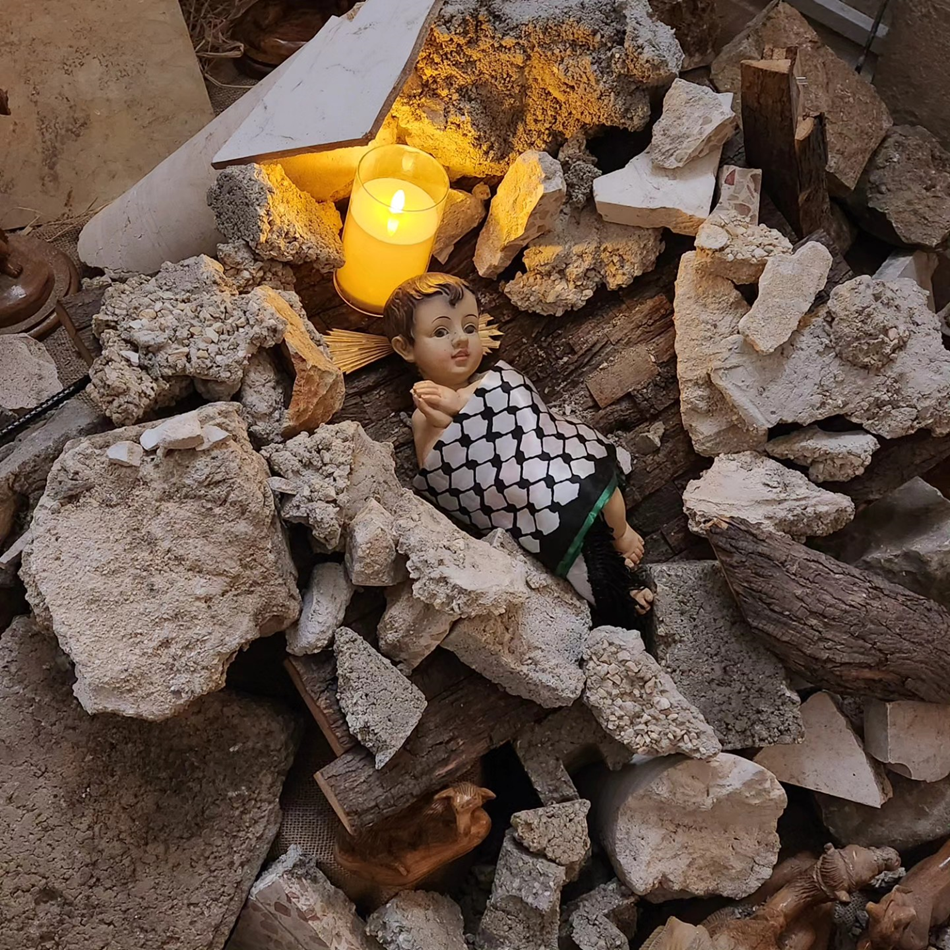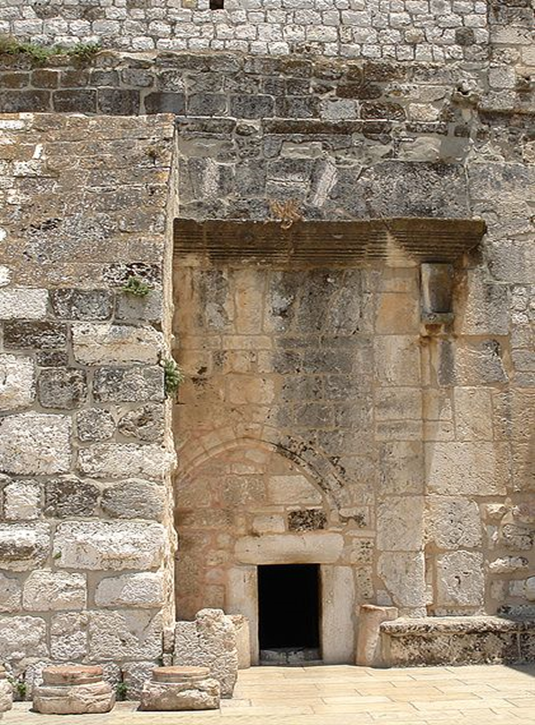
A contemporary Christmas crib in the Lutheran Church, Bethlehem, Photo: Munther Isaac
I am writing this week’s blog while in Malta, a country in which the tradition of nativity cribs is very much publicly alive and flourishing – as indeed in other parts of southern Europe. It is one of the factors that has encouraged me to focus on Bethlehem. So this blog does not relate to a specific lectionary reading, but to a place – which will certainly feature in our worship over the coming days. The next blog will be written for Sunday 7 January and will appear a few days beforehand.
Clare Amos
Director of Lay Discipleship, Diocese in Europe
Clare.amos@europe.anglican.org
We are well into the season of Christmas carol services in which each year we are traditionally exhorted ‘in heart and mind to go even unto Bethlehem and see this thing which is come to pass, and the Babe lying in a manger’. This year, the situation in Gaza, Israel and Palestine makes this invitation – and challenge – to ‘go even unto Bethlehem’ particularly bitter-sweet, not least for the town’s Christian inhabitants, whose livelihoods have been devastated due to the war in Gaza Birthplace of Jesus empty for Christmas due to impact of war – The Jerusalem Post (jpost.com)
What does it mean in such circumstances ‘in heart and mind to go even unto Bethlehem’?
One way of looking at the season of Advent is to think of it as a sort of pilgrimage, a journey being taken by both God and ourselves until the moment when we find ‘God with us, Emmanuel’.
Macrina Wiederkehr defined pilgrimage as follows: A pilgrimage is a ritual journey with a hallowed purpose. Every step along the way has meaning. The pilgrim knows that life giving challenges will emerge. A pilgrimage is not a vacation; it is a transformational journey during which significant change takes place. New insights are given. Deeper understanding is attained. New and old places in the heart are visited. Blessings are received and healing takes place. On return from the pilgrimage, life is seen with different eyes. Nothing will ever be quite the same again.
One of the key aspects of ‘pilgrimage’ is the importance of place. Rowan Williams once said: ‘Place works on the pilgrim . . . that’s what pilgrimage is for.’
Some years ago I designed a series of services for Advent, with the overall title ‘How far is it to Bethlehem?’ Picking up on the idea of pilgrimage, each week we focused on a particular ‘place’ that we needed to ‘journey through’ before – on Christmas Day we were able finally to ‘arrive’ at Bethlehem. The places we visited ‘on the way’ were all mentioned the weekly Advent Gospel readings:
- Advent Sunday: Jerusalem
- Advent 2 and 3: Wilderness and Jordan
- Advent 4: Nazareth
Why was it important that we visited each of these places on our journey to Bethlehem? And what did that mean for how does Bethlehem itself could ‘work on’ us?
Briefly, the focus on ‘Jerusalem’ on Advent Sunday, which each year draws for its Gospel on Christ’s speech on the Mount of Olives (Matthew 24; Mark 13; Luke 21) acts as a reminder to us that Christ is born not in the ‘expected places’ nor in the centre, but ‘on the edge’. Jerusalem has been throughout so much of its history a place where human beings have tried to ‘capture’ and control God: those ‘apocalyptic’ Gospel passages make it clear that the God who comes in Advent has his own timescale, and can appear when and where he is least expected.
Wilderness and Jordan were referred to in my previous blog. They are places ‘on the edge’, places of stripping, of letting go, of being submerged – which we need to do before we can enter the land of promise.
Nazareth speaks to me of God being present in the ‘ordinary’, of God coming in the every-day-ness of our human lives, of an angel who comes to a young woman as she is undertaking her regular task of drawing water from the well. (I think there is something very true about the Christian Orthodox tradition of locating the annunciation at a well!)
And Bethlehem? When I have the privilege of taking groups to this not-so-little-town I ask people if they know which is the first point in the Bible that Bethlehem gets a mention. This generally offers quite a challenge. People certainly move back from the New Testament into the Old – and come up with responses like, ‘the story of David’, or ‘the Book of Ruth’. But actually the first mention of Bethlehem in our Bibles (as they are now set out) occurs much earlier still. You can find it in Genesis 35.19. When Jacob returns from his 20 years of ‘exile’, bringing with him his two wives, Leah and Rachel, Rachel goes into labour and gives birth to her second son, Benjamin, ‘when they were still some distance from Ephrath’. Though Benjamin is born safely Rachel herself, dies in childbirth. And the text then reads, ‘So Rachel died, and she was buried on the way to Ephrath (that is, Bethlehem), and Jacob set up a pillar at her grave.’
When I first realised this, I found it an extraordinarily powerful ‘coincidence’ (if that is an appropriate word), that the first biblical mention of Bethlehem, a town that Christians so much associate with birth, should actually be in relation to a story about death – or rather a story about birth and death. Indeed other mentions of Bethlehem in scripture, such as the story of Ruth or the achingly beautiful oracle of Jeremiah in 31.15 which tells of Rachel weeping for her children, refusing to be comforted ‘because they are no more’, remind us of how close birth and death were – and perhaps still are in many parts of our world. TS Eliot of course caught this in his poem ‘Journey of the Magi’…’Were we led all that way for Birth or Death’?

My own cherished pottery nativity set, made in Bethlehem c. 1975
I was powerfully reminded of Eliot’s words years ago, when I was living in Jerusalem and visited Bethlehem on a bitterly cold February day, to find a funeral going on inside the church, with the coffin placed directly above the Cave of the Nativity. Birth or death? A birth which foreshadows later suffering and death – yet it is only through such a death that new birth is made possible. Bethlehem is a place of paradox, a paradox wonderfully encapsulated in the door to the Church of the Nativity, which is an entrance so low that everyone needs to stoop down to pass through it. It was built in that way to stop people trying to ride into the church on the back of their horses. It expresses in stone the paradoxical truth of the incarnation – sung about more than 1500 years ago by St Ephrem in his Hymns on the Nativity:
‘Blessed be the Child who today delights Bethlehem…
Glory to the Living One whose Son became a mortal;
Glory to the Great One whose Son descended and became small.’

Many of the Christmas carols we sing which refer to Bethlehem I find too sweet – almost sickly – given the realities of today. But there is a lilting Christmas song by Elizabeth Poston which has always expressed for me the intermingling of glory and the tragedy of Bethlehem. It includes the lines, ‘O Bethlehem! Ancient of days, within thy story, heaven was laid. O Bethlehem! Anguish must be the price of glory, for us he paid.’
One of the ironies about Bethlehem is encapsulated in its very name. In semitic languages the word ‘Beth’ means ‘House.’ But the letters ‘Lehem’ can either be linked to a word which means ‘Bread/Food’ or another word which means ‘War’. So the name Bethlehem can mean either ‘House of Bread’ or ‘House of War’. The choice is for us, and for our world today: do we come to Bethlehem to be fed, receiving the bread of life – or do we turn our backs on the ‘one of peace’ (see Micah 5.5) and follow the dangerous path which leads to war? That is a question too relevant to present days.
Is it far to Bethlehem? It is closer than our innermost being – and yet unless we have prepared ourselves to stoop low enough to allow the one who became ‘small’ to ‘enter in’, unless we can learn to cherish Bethlehem’s strange mixture of birth and death, weeping and joy, divinity and humanity, God with us – it is a pilgrimage that we will never finally make our own.
Thank you
Scandalous God,
For giving yourself to the world
Not in the powerful and the extraordinary
But in weakness and the familiar;
In a baby; in bread and wine.
Thank you for offering, at journey’s end, a new beginning;
The richest jewel of your love;
For revealing, in a particular place,
Your light for all nations…
Thank you
For bringing us to Bethlehem, House of Bread,
Where the empty are filled,
And the filled are emptied;
Where the poor find riches,
And the rich recognise their poverty;
Where all who kneel and hold out their hands
Are unstintingly fed. (©Kate Compston)
*****
Malcolm Guite’s beautiful sonnet, ‘Christmas sets the centre on the edge’ resonates with several of the thoughts expressed above and is well worth discovering. https://malcolmguite.wordpress.com/2011/12/23/christmas-on-the-edge/

Tank you Clare, as always you give us a lot to think about and meditate on. Emma
LikeLike